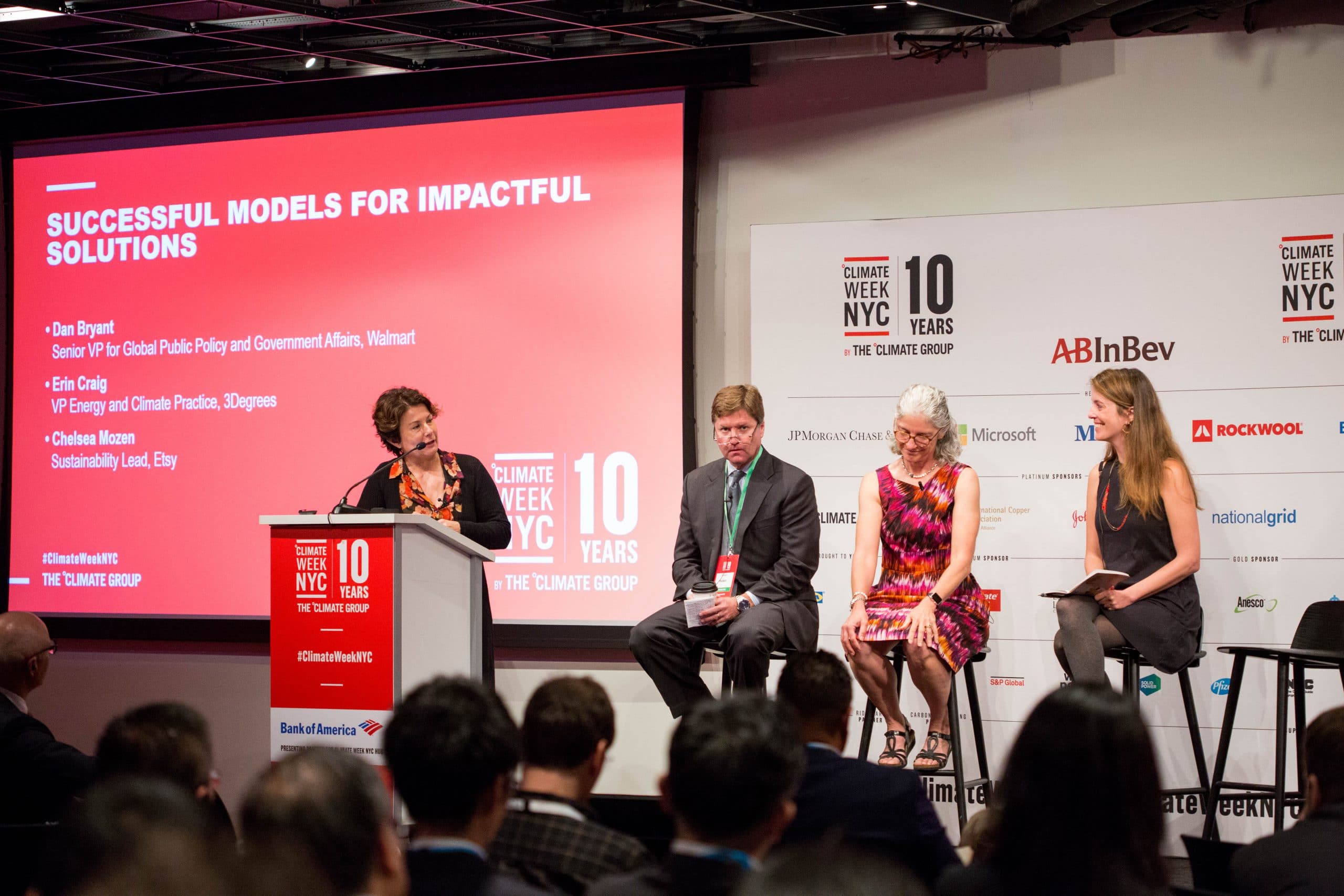Last week, I attended Climate Week NYC in the company of hundreds of climate concerned leaders from around the world. I was happy to be part of it; if my only way to gauge progress on climate action was by tracking political news, by following social media trends or by reading the latest scientific research, I suspect I’d spend my days in a haze of semi-depression.
But I don’t! After years of supporting customers as they frame and drive their sustainability agendas, I have a very different perspective. I’m not downcast at all actually: I feel more inspired and motivated and hopeful than ever before. At Climate Week NYC, I had the pleasure of participating on a panel addressing “Solutions for a 100% Clean Energy Transition”, alongside fellow sustainability thought leaders Dan Bryant, SVP, Global Public Policy and Government Affairs at Walmart, and Chelsea Mozen, Sustainability Lead at Etsy, and moderated by Samantha Smith, Director of Just Transition Centre. These effective and purposeful people inspired me right there on the spot, and I shared several additional reasons for my optimism.
IT’S NOT A MATTER OF “IF”, IT’S A MATTER OF “HOW FAST”
Organizations all over the world are stepping up in the quest to reduce global greenhouse gas emissions. Just before our panel took the stage, Mike Peirce, Corporate Partnerships Director for The Climate Group, shared that it took 40 years to achieve one terawatt of renewable energy… but we expect it to take only five years to get to the next terawatt. The pace of renewable energy development – just one indicator – is remarkable and accelerating. That momentum, and the commitment and desire to succeed which drives it, was palpable last week in New York.
THERE’S A PATH FOR EVERYONE
As we tell our clients, there is a path to renewable energy adoption for every company but those paths will not all look the same. If an organization is ready to implement a renewable energy strategy, then I am 100% certain they can achieve ambitious emission reductions. There will be at least one solution available somewhere along the continuum; from onsite renewable energy to aggregated PPAs or VPPAs, from utility green tariffs to competitive retail energy….there is truly something for everyone.
Exhibit A: my two fellow Climate Week NYC panelists, Walmart and Etsy, both members of the RE100 initiative led by The Climate Group as the world’s largest retailer, Walmart has set an aggressive renewable electricity goal within their corporate context of delivering consistently low prices to their customers. To date, 26% of Walmart’s global operations are powered by renewable electricity, with a target of 50% by 2025.1 On the other end of the spectrum, e-commerce website Etsy is proudly embracing its role as the smallest player in the largest renewable energy aggregation to date, together with Apple, Akamai and Swiss Re. Two completely different organizations, with vastly different budgets and corporate goals – but both making a meaningful impact with their approach to renewable energy solutions.
Our conference room was filled with attendees representing highly diverse organizations. And, as I shared during the panel, the most critical question to start with is “What is your why?” What are the driving forces behind sustainability at your company? Cost savings? Brand value? Corporate ethos? Investors or advocates? Because once you understand your “why”, you can build an implementation strategy that amplifies your responsiveness to your particular driving forces.
THE BUSINESS CASE IS THERE
Several themes surfaced repeatedly at the conference, but perhaps one of the most prominent was the business case for renewable energy. Put simply: more organizations across the globe are embracing renewable energy solutions because they make good business sense.
It makes financial sense, as renewable energy continues its march toward cost parity with fossil fuels all over the world. It makes sense for job creation; the renewable energy sector now employs over 10 million people worldwide.2 And it makes sense for the harder-to-measure, yet highly valuable, metric of stakeholder engagement. During our session, both of my fellow panelists cited examples of how their companies’ sustainability strategies directly impacted this metric in the form of new employee recruitment and morale (Walmart) and internal employee engagement and enthusiasm (Etsy).
So, despite the fact that it was a dark and stormy day in New York during our Climate Week NYC panel, all of these reasons are why I felt bright and optimistic about the direction we are headed in our quest to achieve a 100% clean energy transition. I truly believe that it’s not a matter of if we’ll get there, it’s a matter of when and how fast.
1 RE100 Progress and Insights Report 2018
2 IRENA Renewable Energy and Jobs 2018 Annual Review


